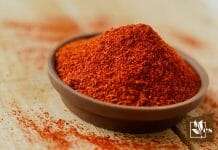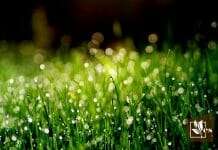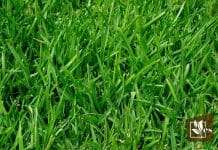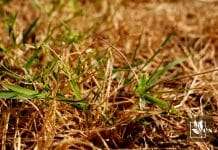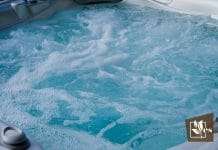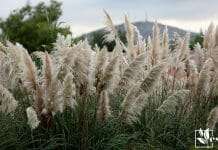Bermuda grass vs Kentucky is an important comparison, especially if you live in states that are in the transition zone. Both grass types are soft, yet tough, and able to regenerate when damaged.
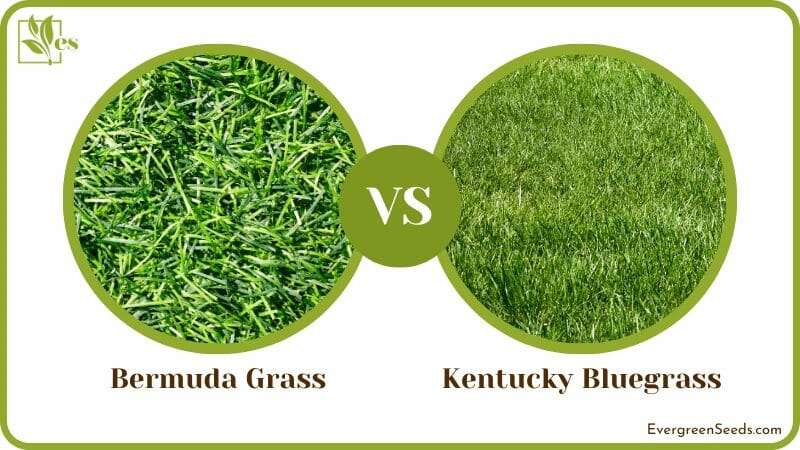
In this article, we have conducted an in-depth comparison of these two common grass types. We also have a comparison guide on Zoysia Grass and Bermuda Grass. Find out which one suits the area you are in, your personal preference and what you need the most by carrying on reading ahead.
JUMP TO TOPIC
Bermuda Grass vs Kentucky Bluegrass
| Bermuda | Kentucky Bluegrass | |
| Scientific Name | Cynodon dactylon | Poa pratensis |
| Leaf Blade Description |
|
|
| Type of Grass | Warm growing | Cool growing |
| Roots | Deep, long and extensive system | Shallow system |
| Tolerance for Drought | High tolerance | Low tolerance |
| Temperature Needs | 95 to 100 degrees Fahrenheit | 60 to 75 degrees Fahrenheit |
| Durability and Recoverability |
|
|
| Preferable Usage |
|
|
| When To Mow | Mow whenever the leaf blades grow half an inch to two inches long. | Mow this grass type when the leaf blades grow about three inches long. |
What Are The Differences Between Bermuda Grass and Kentucky Bluegrass?
The major difference between Bermuda and Kentucky bluegrass is that Bermuda is a warm growing grass, whereas Kentucky is a cool growing one. Kentucky bluegrass is softer and has higher tolerance and recoverability for foot traffic than Bermuda. On the other hand, Bermuda has higher drought tolerance and is classified as an invasive species.
What Are The Characteristics of Bermuda Grass?
Bermuda grass is best recognized for its ability to grow in hot summers and tolerate drought conditions. It has a fast and invasive growth habit that requires a steady level of regular lawn maintenance.
– Bermuda Is a Warm Season Grass
Bermuda is a classic summer-season lawn grass that thrives in hot temperatures. Their grass seeds start germinating in the beginning of spring, and the grass blades turn green in late spring when the temperatures start rising.
The hotter it gets, the greener and thicker this lawn gets. Ideal temperatures will be between 95 to 100 degrees Fahrenheit during the day. The seedlings and rhizomes will not grow unless the soil temperature rises above 65 degrees.
As expected, this grass cannot tolerate cold and will begin to undergo dormancy as early as fall. Below 55 degrees, it will turn brown from green. Below 30 degrees, it will stop growing altogether and go dormant.
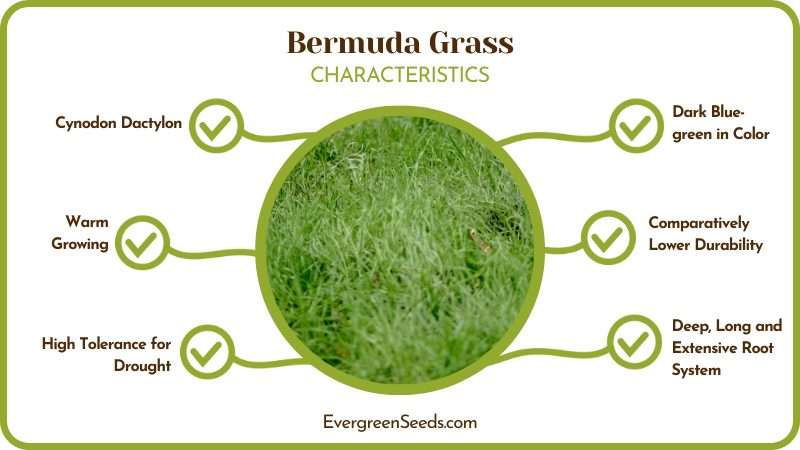
– It Is Drought Tolerant
Bermuda is a tough type of grass and will continue growing under even the most stressful of conditions, such as drought. This makes it perfect for areas where regular availability of water for lawn maintenance might be a hassle or even impossible. Every week, only a quarter inch of water is enough to keep this grass green and growing. That is obviously not the optimum situation.
Of course, it needs frequent watering to stay green and fresh. When grown in well-draining soil, it will need about one to one and a half inches of water every week. Only one-quarter of an inch per week should be enough in sandy soil types.
– It Is An Invasive Type of Grass
Without constant lawn care and maintenance, this grass can get out of control. This is because it is an invasive specie with high seed production and dispersal levels. Its ability to grow in a large variety of adverse conditions means that it soon spreads beyond the boundary where it is planted.
Soon after germination, Bermuda grows, a long and extensive system of roots spread deep underground. These highly competitive roots can redirect nutrients and moisture from other grass or nearby plants. As a non-native variety, there are not many natural predators available that can keep its prolific growth in check.
That is why you need to keep its spread in check constantly. Keep mowing it regularly, and pull it off manually if it seems to be spreading outside a designated boundary. You can take help from weed-pulling gardening equipment as well. Very few herbicides are effective against it, and you can take help from any of them.
– It Needs Bright Direct Sunlight
This lawn and turf grass will not grow well unless given full, bright sunlight for at least eight hours each day. Even during the peak of hot summer days, this grass will thrive the most and develop the most vibrant colors.
If the sunlight is bright enough but partial or indirect, your grass might still grow, but it will not be as healthy as grass grown in full light. Under shaded conditions, your grass will not grow at all.
If shaded areas are on your lawn, you can mix Bermuda with another grass type growing under well-shaded conditions.
– It Can Repair Itself
Among warm-growing grass types, Bermuda is the one that can repair itself rather quickly. It can tolerate being walked and trampled upon quite well, especially if the leaf blades are kept small and well-mowed.
Small to moderate-sized patches of grass that get damaged will be repaired by themselves without your intervention—all you have to do is ensure that the soil remains well-fed with proper nutrition and watering.
Feed your Bermuda lawn grass around late winter or early spring, as it is the best time to feed it. Go for a well-balanced grass fertilizer that is slow-release in nature to last for the next three to four months.
– It Will Take Root In All Soil Forms
Like fine fescue and buffalo grass, Bermuda is a grass that will grow anywhere. Any soil from sandy to clay-like to well-draining is good enough for this invasive grass.
It will grow equally well in both acidic and alkaline soil. It can tolerate saline soil and water conditions, unlike most common grass varieties. That is why it will grow healthily in coastal areas as well.
What Are The Characteristics of Kentucky Bluegrass?
Kentucky bluegrass is one popular, soft, and foot tolerant among all cool-growing grass types. It has poor shade tolerance but needs regular fertilization and trimming.
– It Is One of The Most Popular Cool Season Grasses
Not only the most popular, but Kentucky is also the hardest among all other cool-season grasses. Technically these grass types are well-suited to the northern colder areas of the US or the transition zone states of Virginia, Delaware, North Carolina, etc.
This grass will either go into dormancy, or its leaf blades will burn up in places where the summers are hot and dry. Their grass blades and underground rhizomes cannot tolerate temperatures above 80 degrees Fahrenheit. They also cannot tolerate frost and below-freezing temperatures either.
It is also one popular grass type in the northern coastal areas, where the maximum summertime temperature is about 65 to 75 degrees Fahrenheit. You will see this grass sprout its blades in early spring, lasting all summer until the late fall period. It might even survive the whole winter season if it is mild enough.
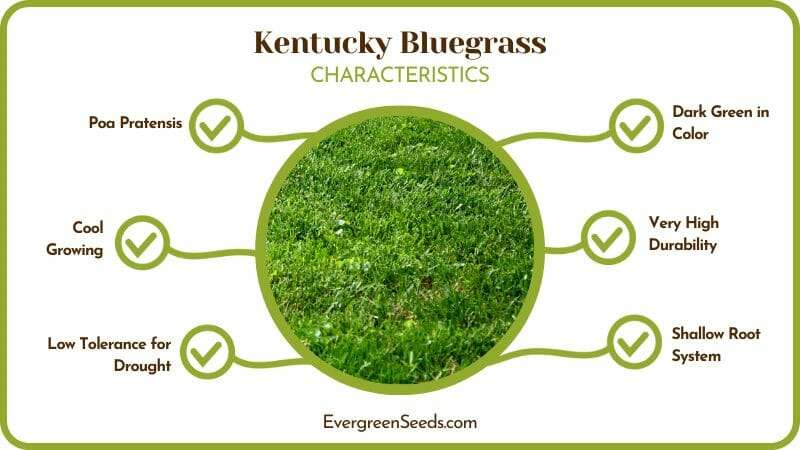
– Needs Regular Fertilizing
This grass type needs to be fertilized once a year regularly to speed up its growth and germination of new seeds. The best time to fertilize Kentucky and other cool-season grass types are during autumn. You can also apply a diluted fertilizer occasionally for the rest of the year.
During autumn, apply a nitrogen-rich fertilizer to help the grass in its most vigorous root-growing phase. It is better to select a slow-release formula that comes in the form of pellets that are then buried into the soil. In the case of a liquid fast-release formula, always dilute the fertilizer beforehand.
For the rest of the year, fertilizer is only once a month or every eight weeks. For this, you need regular and well-balanced fertilizer with an NPK ratio of 12:12:12. Go for a liquid feed and deeply dilute it before pouring it onto the grass.
– Poor Shade Tolerance
No, you cannot plant bluegrass in shady areas with poor access to sunlight. This grass with high sunlight requires eight hours of direct light daily. The more sun it receives, the more deep the blue-green color of its leaf blades will be.
If it gets only partial light throughout the year, there will be a marked decrease in the quality of this lawn grass. The ideal condition would be to plant it someplace where at least a few hours of direct light falls.
Direct light early in the morning or mid-afternoon is the most effective for any grass. Indirect light for the rest of the day should suffice later on.
– Reasonably Good Foot Traffic Tolerance
Although this grass has shallow roots, it grows quickly and densely throughout the turf. This makes it a well-suited grass for lawns subject to high levels of foot traffic. If you want your pets and kids to have fun in the yard and play around, then this just might be the type of grass for you.
Bluegrass has very soft grass blades that make it such a pleasant experience to walk over it. These properties make it the most popular grass choice for school grounds and golf courses.
As fast-growing species, this grass will no doubt need constant maintenance. Whenever the grass blades become three inches tall, you need to mow them. Naturally, shorter grass blades are more resistant to foot traffic than longer ones.
– Perfect for Lawns, Turfs, and Sports Gardens
Bluegrass is the number one grass option for home lawns, roadside turfs, and athletic sports grounds. It has one major advantage over another famous turf side grass, the tall fescue, which is its soft and smooth texture.
It can withstand significant foot traffic and has one of the fastest repair abilities among all grass types. You can play football over a lawn planted with bluegrass all you want, and it will not get damaged.
Being a perennial, it will continue to grow by itself yearly by self-sowing grass seeds with a very high germination rate.




